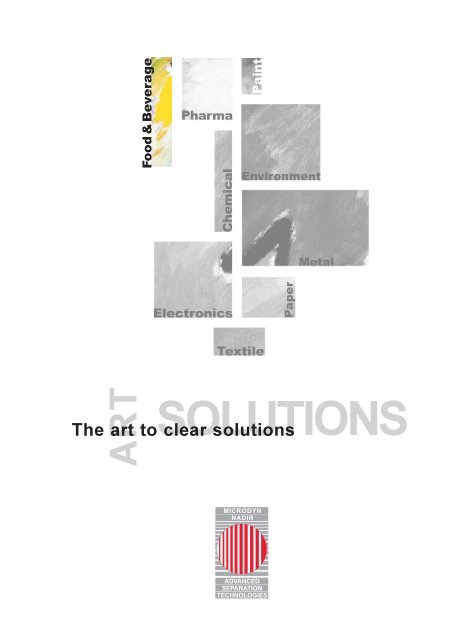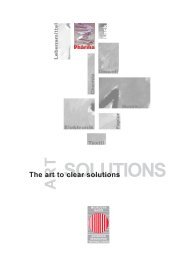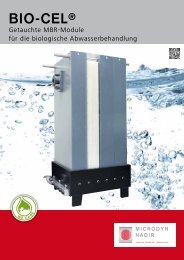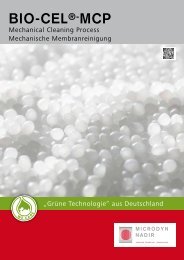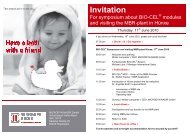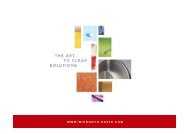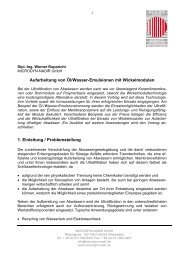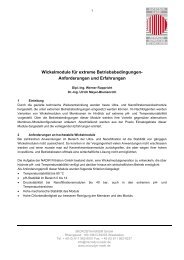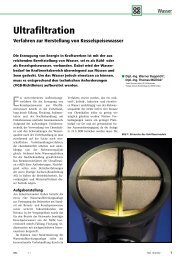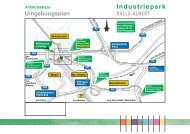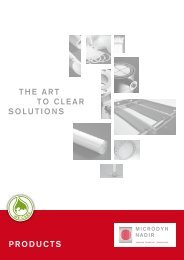SOLUTIONS - MICRODYN-NADIR GmbH
SOLUTIONS - MICRODYN-NADIR GmbH
SOLUTIONS - MICRODYN-NADIR GmbH
Create successful ePaper yourself
Turn your PDF publications into a flip-book with our unique Google optimized e-Paper software.
ART<br />
Food & Beverage<br />
<strong>SOLUTIONS</strong><br />
The art to clear solutions
Beverages -<br />
Proteins and more...<br />
In recent years membrane filtration as a modern<br />
and innovative technology has undergone significant<br />
developments and meanwhile has moved into the<br />
mainstream of the food processing market.<br />
This was achieved by a wide variety of new products<br />
adapted to the special needs of the food & dairy<br />
industry.<br />
Backed-up by the many years of experience and<br />
developmental work in membrane filtration of her<br />
parent companies - Hoechst AG and Akzo AG -<br />
<strong>MICRODYN</strong>-<strong>NADIR</strong> contributes substantially to the<br />
steady growth of membrane filtration becoming<br />
a requirement in the food & beverage sector. Today<br />
more effective membrane based separation units<br />
for numerous food processes are available.<br />
These help save energy and resources while<br />
accomplishing better quality products.<br />
<strong>MICRODYN</strong>-<strong>NADIR</strong> membranes match well with<br />
the various pressure driven processing modes such<br />
as cross-flow, semi- and dead-end operation under<br />
regular and extreme conditions.<br />
<strong>MICRODYN</strong>-<strong>NADIR</strong> supplies membranes made of<br />
PP, PE, PES, PVDF and regenerated cellulose.<br />
The main fields of application of our MF, UF,<br />
and NF membranes in food & beverage industry<br />
are the concentration or fractionation of proteins<br />
and the clarification of fluids.<br />
<strong>MICRODYN</strong>-<strong>NADIR</strong> membranes and modules are<br />
used in dairy processes such as milk standardization,<br />
concentration of milk and whey, cheese production<br />
and brine clarification. Our products are<br />
also successfully employed in the concentration<br />
of liquid egg, gelatin, animal blood, starch, yeast,<br />
as well as for the removal of micro-organisms<br />
and cells etc.
SPIRA-CEL ®<br />
A new generation of membrane products<br />
Our new generation of membranes and elements<br />
for the micro-, ultra- and nanofiltration provides better<br />
performance and stability and is compliant with<br />
FDA-specifications.<br />
Our membranes are available in roll stock, flat sheet,<br />
hollow fiber cartridges, tubular configuration and a wide<br />
range of standardized or customized spiral wound<br />
modules depending on the required membrane material<br />
and molecular weight cut-off (MWCO).<br />
Food & Dairy products<br />
in general<br />
Milk and whey<br />
Cheese production<br />
Cheese brine clarification<br />
Liquid egg<br />
Gelatine<br />
Vinegar<br />
Dextrose<br />
Fruit juice<br />
Wine<br />
Food gums<br />
Starches<br />
Sweeteners<br />
Fishbrine<br />
Soymilk<br />
CIP-fluids<br />
MD 150<br />
Application Features Benefits<br />
Concentration<br />
Standardization, recovery of proteins<br />
and lactose<br />
Protein concentration<br />
Removal of micro-organisms like moulds,<br />
yeast, pathogenic bacteria<br />
Simultaneous processing of fermentation<br />
and concentration<br />
Concentration<br />
One step clarification<br />
Clarification<br />
Clarification<br />
One step clarification<br />
Concentration and purification in one step<br />
Concentration and recover<br />
Clarification of syrups<br />
Clarification<br />
Concentration of proteins<br />
Recovery of detergents and chemicals<br />
Modules are available in sanitary and industrial versions<br />
for high temperature and high pH conditions.<br />
Our production processes meet the FDA standards,<br />
and we demand all our suppliers to do so as well.<br />
We assist our customers in process development with<br />
our lab & pilot service. Our capabilities for field service<br />
and short delivery times, also for custom products,<br />
are more essential qualities of the <strong>MICRODYN</strong>-<strong>NADIR</strong><br />
organization.<br />
Low energy consumption, no degradation and/or<br />
heat deterioration of the product<br />
Purified product, higher yield and easy protein recovery<br />
High yield, fractionation of proteins<br />
No alteration of the chemical composition of the brine,<br />
no denaturation of the whey proteins<br />
Purification and concentration in one step,<br />
lysozyme separation<br />
Higher quality<br />
No use of diatomaceous earth<br />
No use of diatomaceous earth, compact system design,<br />
concentrate used as animal fodder<br />
High juice recovery, no use of fining additives and<br />
diatomaceous earth, upgrading of citrus juices<br />
No prefiltration necessary, no use of fining agents,<br />
filtersheets and diatomaceous earth<br />
Continuous plant operation<br />
Compact system design and low operational costs<br />
Membrane resists high salt and pickles resistance.<br />
Low initial investments<br />
Energy savings, economical system design<br />
Waste reduction
Shell and<br />
embryo<br />
removal<br />
Concentrating liquid egg<br />
by membrane filtration<br />
Feed tank<br />
Feed egg white<br />
Simplified Flow Diagram<br />
Dual in-line<br />
Filters<br />
Use for displacing product<br />
Stage 1 Stage 2<br />
The concentration of liquid egg is one important<br />
application, in which membrane ultrafiltration has<br />
proven to be a profitable process to obtain highest<br />
product quality.<br />
After egg breaking and the removal of shell and<br />
embryo, the liquid egg is slowly fed into the membrane<br />
filtration unit. This can either be built as<br />
a single-stage system for batch operation or as a<br />
multi-stage system which allows feed-and-bleed<br />
processing. Good care is taken to protect the easily<br />
damaged white of egg against destructive mechanical<br />
or thermal stress during the process operation.<br />
Shear stresses which may lead to irreversible<br />
deterioration of the proteins are minimized by the<br />
correct selection of the pumps. The use of positive<br />
displacement pumps should be used to conserve<br />
the valuable whip properties of the albumen.<br />
Konzentrat<br />
Permeate<br />
Retentate<br />
The process temperature has an essential influence<br />
on the stability of the product, but is also of great<br />
importance for the permeate flux. The latter strongly<br />
depends on the membrane and the module type.<br />
SPIRA-CEL ® -modules and membranes<br />
by <strong>MICRODYN</strong>-<strong>NADIR</strong> with a MWCO ranging from<br />
5 to 20 kDa enable the economical concentration<br />
at temperatures in a range from 15 to 35°C, in which<br />
denaturation or coagulation of proteins do not occur.<br />
Depending on the membrane spacer the whole egg<br />
can be concentrated up to 45% TS (Total Solids),<br />
while the concentration of pure white of egg<br />
is limited to 32% TS.<br />
The advantage of these membranes is that proteins<br />
are rejected while low molecular weight molecules<br />
like glucose and salts can pass freely. Thus desalting<br />
and concentration can be combined during the fermentation<br />
process, which results in a shorter total<br />
processing time. The UF-retentate is transferred<br />
to a heat exchanger for further concentrating or fed<br />
into a spray dryer to produce egg powder.<br />
Occasionally, ultrafiltration is also used to recover<br />
valuable egg components from detergent free wash<br />
water, which is spent in large volumes for rinsing egg<br />
processing machines. The extraction of lysozyme<br />
is another application that benefits from the use<br />
of UF-membranes with low MWCO.
Features<br />
of Cross-Flow Filtration<br />
Feed Flow<br />
Permeate<br />
In cross-flow filtration the fluid feed stream is fed<br />
across the membrane. This concept supports turbulent<br />
mixing of the fluid stream during the filtration<br />
process and prevents the deposition of particles on<br />
the membrane surface. Particles that have already<br />
sedimented are flushed away.<br />
Concentrate<br />
Membrane<br />
Formation of gel layers on the membrane at<br />
the concentrate end during the filtration of proteins<br />
is prevented by cross-flow filtration. This gel layer<br />
strongly affects the membrane performance and<br />
can only be removed by frequent rinsing.<br />
Thus cross-flow filtration maintains stable permeate<br />
fluxes over longer periods of time even with liquids<br />
which are difficult to process.<br />
All in all, the prevention of membrane fouling<br />
and the enhanced fluid mixing lead to a better<br />
membrane performance and ongoing stable<br />
process during cross-flow filtration in comparison<br />
to conventional dead-end processes.<br />
The efficiency of the cross-flow filtration of liquids<br />
is mainly determined by the correct choice of<br />
membrane type construction of the module, main<br />
parameters of the process, pressure and crossflow-velocity.<br />
Furthermore the process performance<br />
depends on many different factors.<br />
<strong>MICRODYN</strong>-<strong>NADIR</strong> has long experience in the<br />
evaluation of the influencing factors to optimize<br />
membrane processes.
L@L Design • Getty Images<br />
Support<br />
Pre-Sales<br />
Product information for membranes and modules<br />
Technical advice and recommendations for application<br />
Systems and processing advice<br />
Process and method evaluation<br />
Laboratory evaluation<br />
After Sales-Service<br />
Implementation of effective cleaning methods<br />
Module cleaning<br />
Evaluation of cleaning methods<br />
Servicing of modules in operation<br />
Please contact us for further information about<br />
<strong>MICRODYN</strong>-<strong>NADIR</strong> products & applications.<br />
Paint & Automotive<br />
Pharma & Biotechnology<br />
Environment<br />
Chemical<br />
Metal<br />
Electronics<br />
<strong>MICRODYN</strong>-<strong>NADIR</strong> <strong>GmbH</strong><br />
Rheingaustr. 190 - 196 • D-65203 Wiesbaden<br />
Tel.: + 49 (0) 611- 962 - 6001 • Fax: + 49 (0) 611- 962 - 9237<br />
info@microdyn-nadir.de • www.microdyn-nadir.de<br />
<strong>MICRODYN</strong> TECHNOLOGIES INC • USA<br />
Po Box 98269 • Raleigh NC 27624<br />
Phone: + 1 919 872 - 9375 • Fax: + 1 919 872 - 9375<br />
infoUSA@microdyn-nadir.de • www.microdyntech.com<br />
1401


